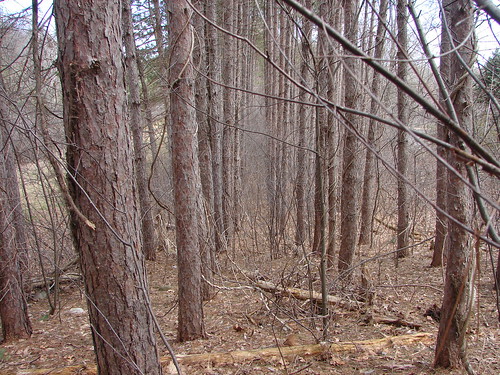 This is DEFINITELY a Red Pine plantation. There are four perfectly straight rows of pine trees that go on for as far as the eye can see. Even if I didn't notice something strange about these trees on my own, (which I did), I would have picked up on the concept after reading a brochure by the Sudbury Valley Watershed Association (which is somehow related to the MWRA). According to the article, "The current Sudbury forest originates primarily from plantation establishments from 1907 to 1947".
This is DEFINITELY a Red Pine plantation. There are four perfectly straight rows of pine trees that go on for as far as the eye can see. Even if I didn't notice something strange about these trees on my own, (which I did), I would have picked up on the concept after reading a brochure by the Sudbury Valley Watershed Association (which is somehow related to the MWRA). According to the article, "The current Sudbury forest originates primarily from plantation establishments from 1907 to 1947". 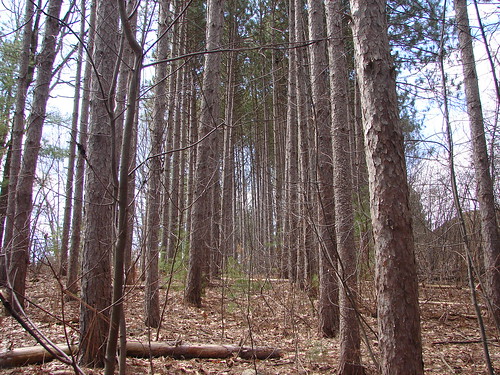 Why would the entire Sudbury River Watershed be covered with Pine Tree Plantations in the first place? The area in question is not small.
Why would the entire Sudbury River Watershed be covered with Pine Tree Plantations in the first place? The area in question is not small. 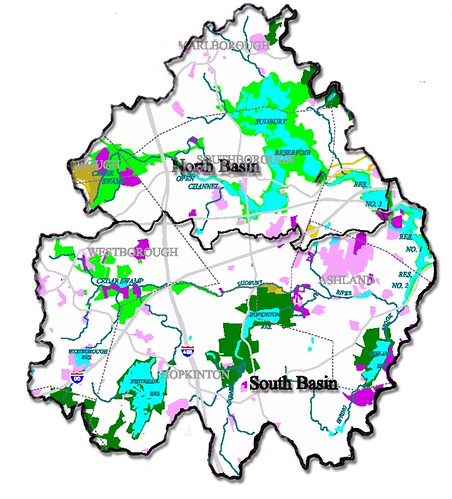 There had to have been many owners deciding to invest 50 or 60 years before they made a profit from their land. Does that make sense? And why specifically mention the year 1907? What happened in 1907 to make pine plantations so popular?
There had to have been many owners deciding to invest 50 or 60 years before they made a profit from their land. Does that make sense? And why specifically mention the year 1907? What happened in 1907 to make pine plantations so popular?  Actually, I don't think these trees are from 1907. I don't think they are over 100 years old. These appear to be about 50 years old to me, or even less. I'm no expert in calculating the age of a tree, though. I'm totally guessing. I know there is not usually a direct correlation between size and age in natural forests, but plantations are a little different. But a little research should uncover the answer.
Actually, I don't think these trees are from 1907. I don't think they are over 100 years old. These appear to be about 50 years old to me, or even less. I'm no expert in calculating the age of a tree, though. I'm totally guessing. I know there is not usually a direct correlation between size and age in natural forests, but plantations are a little different. But a little research should uncover the answer. These trees are planted alongside the Hultmann aqueduct, but on one side only! That must be a clue! The Hultmann was completed in 1940, which MUST predate this plantation. They can't have been planted as a wind break or to stabilize the soil, though. All Pine's have shallow roots, and all pines topple over quite easily in strong winds.
 Red Pine plantations are designed to be cash crops, anyway. The government doesn't plant cash crops, do they? These pines are on government land, although which agency (MWRA, DCR, Town of Framingham, etc.) actually owns the land, I have no clue)
Red Pine plantations are designed to be cash crops, anyway. The government doesn't plant cash crops, do they? These pines are on government land, although which agency (MWRA, DCR, Town of Framingham, etc.) actually owns the land, I have no clue) 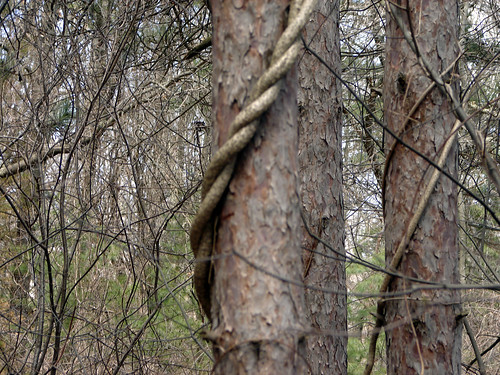 I wonder if anyone in the government knows (or cares) that Bittersweet is overtaking the pines and everything else that grows around here? In a few decades there won't be a pine standing, anyway. There won't be any other trees, either. There will only be massive tangled vines of bittersweet. I guess no one will profit from this plantation, after all. But the good news is that NOW I KNOW WHY THE EAGLE FLIES ALONG THIS AQUEDUCT!!!
I wonder if anyone in the government knows (or cares) that Bittersweet is overtaking the pines and everything else that grows around here? In a few decades there won't be a pine standing, anyway. There won't be any other trees, either. There will only be massive tangled vines of bittersweet. I guess no one will profit from this plantation, after all. But the good news is that NOW I KNOW WHY THE EAGLE FLIES ALONG THIS AQUEDUCT!!!  It's a straight shot from the Foss Reservoir to Lake Cochituate! With a convenient stop at the Sudbury River in Saxonville! It's a perfect route; visible prey, out of human sight if you stay below the tree line, and a built-in wind tunnel thanks to the parallel trees! I'm going to look for the eagle's nest at the Foss Reservoir, near Bose. I'll bet it's near there somewhere!
It's a straight shot from the Foss Reservoir to Lake Cochituate! With a convenient stop at the Sudbury River in Saxonville! It's a perfect route; visible prey, out of human sight if you stay below the tree line, and a built-in wind tunnel thanks to the parallel trees! I'm going to look for the eagle's nest at the Foss Reservoir, near Bose. I'll bet it's near there somewhere!

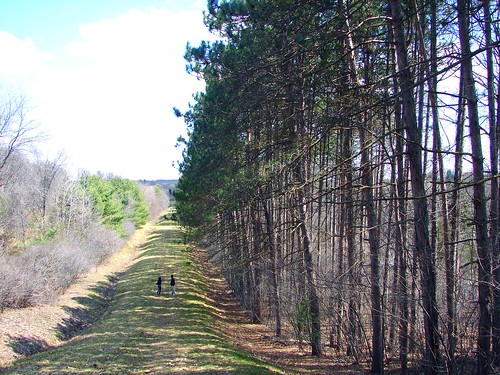
I'd always wondered about those stands of trees! We have them along the aqueduct on Water St. & Potter Rd.
ReplyDeleteMore concerning to me than the bittersweet in this town is the poison ivy...vines big enough to take over trees, and it's EVERYWHERE...we can't even go walking in the woods (or even the side of the road) from April to November it's so prolific. I wish the town could at least spray the poison ivy along sidewalks and near the schools.
As always, you answer the most fascinating questions around town. :-)
You're very kind, but so far I have more questions than answers! I WILL find out who planted these plantations, why they planted them, and what they intend to do with them - eventually. I'm very persistent and love mysteries.
ReplyDeleteThe problem with bittersweet is that it is not native, and therefore has no natural competitors. It proliferates wildly, it is nearly impossible to kill or contain, and if we don't figure out how to control it, it could kill every tree in New England. Which would be the end of us.
Another concern, especially if you have children, is ticks and Lyme disease. Lyme disease can lead to serious autoimmune problems (although the government denies it and most doctors haven't got a clue.) Like poison ivy, though, the cure is as deadly as the disease. Spraying pesticides on your kids is horrifying, but not protecting them is unthinkable as well.
I don't mean to sound pessimistic. Someday, someone will figure out a way to solve all these problems; I am sure of it. In the meantime, we are living in a beautiful and fascinating world, and I am loving every bit of it!
I haven't experienced any problems with ticks here, but that's probably because I'm comparing it to where I grew up--on Long Island--where the deer ticks and Lyme Disease were so prevalent that one could not be a blood donor if they lived there!
ReplyDeleteThe poison ivy was bad there too. The worst "pest" in Framingham so far for us is the mosquitos!! But we live near a lot of stagnant water, so it figures.
Can't wait to hear you solve the Pine Plantation Mystery!
wow, that's pretty good post. i think it has to do with water retainance (sp ?). a slope with pines and no ground cover can't absorb the water in case of heavy rain. not sure it's good for the soil though and not sure it makes too much sense either. maybe they were meant to be harvested and nobody got the memo.
ReplyDeleteYour comment just gave me another idea, framingham! Planting pines with shallow roots may have been a technique to prevent other species of trees from regenerating next to the aqueduct. Anything but pines would eventually damage the aqueduct with their large, expansive root system. It is a great idea, actually. Nothing will survive long enough to cause root problems under a closed canopy of pine trees. It is a better option than having to mow all the land adjacent to the aqueduct for 60 years, for sure.
ReplyDeleteFinally an explanation that makes sense! Thank you, framingham forum!
i kinda googled around and it seems to be for water quality purposes (at least, that's the reason for quabbin). no ground cover means better water (it seems) downstream.
ReplyDeleteThe largest Red Pine recorded in the US is 45 inches in diameter, 122 feet tall, and is located in Gogebic County, Mi. in the Upper Peninsula. Many of the older red pine plantations you see on public forests are legacies of the Civilian Conservation Corps. (CCC) which were planted soon after the Great Depression.
ReplyDelete